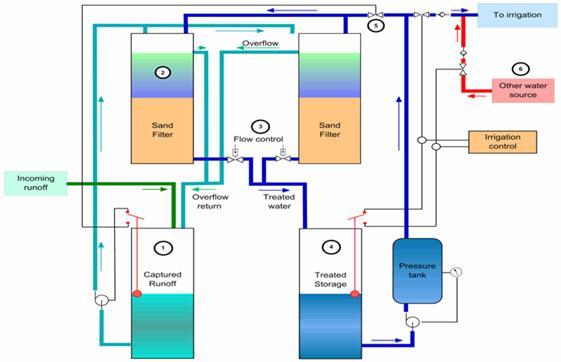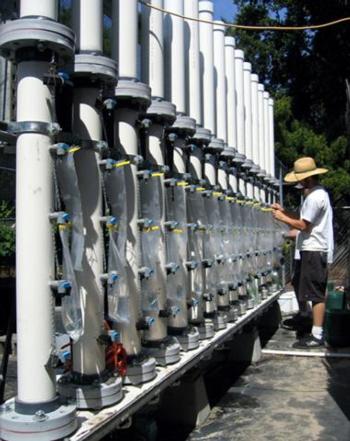Update of Slow Sand Filtration Research
by Loren Oki
Water discharges from California nursery and greenhouse production facilities are regulated by the Irrigated Lands Regulatory Program of the State Water Resources Control Board. These discharges include runoff from irrigation, drain tile flows, and storm water runoff and can contain pollutants generated from the activities associated with the production of horticultural crops. These pollutants — which might include pesticides, nutrients from fertilizers, sediments, pathogens and heavy metals — can reach and impair surface and groundwater. For more information on the Irrigated Lands Regulatory Program, go to: http://www.swrcb.ca.gov/water_issues/programs/agriculture/.
To comply with these regulations, many nursery and greenhouse operators have captured runoff to prevent it from leaving the growing grounds and reuse it for irrigation. This not only prevents potential downstream and groundwater pollution but also conserves water. However, the captured water still contains the pollutants, and the plant pathogens are of specific concern. Irrigating plants with the captured water that contains pathogens can cause widespread disease.
Treatment methods to remove the pathogens are typically based on exposing the water to chemicals, heat, or radiation (e.g., chlorine, pasteurization, and UV, respectively). However, these methods require large inputs of chemicals or energy. Alternative sustainable methods have become more prevalent and include the use of constructed wetlands and slow sand filters. These methods, previously discussed in UCNFA News [(Oki and White 2011) (see References below)], require no chemicals and less energy to remove plant pathogens from captured runoff. This article focuses on the slow sand filtration treatment method in which microbial activity removes or deactivates pathogens so they are unable to cause disease.
Introduction
Slow sand filters have been used for centuries to produce drinking quality water and only recently have become of interest to treat runoff from horticultural operations. Probably because of their similar names, slow sand filters are often confused with rapid sand filters. Slow sand filters and rapid sand filters are both used to physically remove particulates. However, rapid sand filters are distinctly different from slow sand filters because they are not capable of removing smaller particles, substances dissolved in the water and most pathogens.
Slow sand filters (SSFs) consist of a sand bed about 3 feet deep, submerged in another 3 feet of water. The quality of the sand is critical for optimal treatment performance. The sand grains should be round, not sharp, and about 0.3 mm in diameter (about 60 mesh). The sand serves as a substrate on which a community of microbes grows that is responsible for the treatment. Water flow through SSF systems is gravity driven and they can be designed to only require that the water be lifted up to the top of the filters to create a pressure head (fig.1). Controlling the flow rate of water through the sand bed is also critical for treatment and flow rates should be about 800 gallons per day per square yard of sand surface area. At that rate, a sand bed in a 20 foot diameter tank is required to treat 25,000 gallons of captured runoff per day. A recommendation is to capture runoff in a large tank or pond and pump the captured water to the sand beds. This is because the flow through the sand beds needs to be slow and continuous and runoff usually occurs in surges, depending on the timing of irrigation cycles. Another tank is necessary to collect the treated water to be used for irrigation.

It is also recommended that two sand beds are installed so that while one is shut down for maintenance, the other can remain operational. SSF systems need relatively little maintenance but require periodic cleaning of the sand surface as the layer of microorganisms (“schmutzdecke”) thickens at the sand bed surface and restricts flow. The frequency of the cleaning depends mainly on the particulate content of the water being treated. These particles, typically sediment, clog the filters which restricts the flow of the water. Pretreating the water to remove the sediment will be necessary to extend the time between cleanings. This can be accomplished by slowly flowing the water through settling ponds or using flocculants.
Research Project
In the experimental system we constructed at UC Davis, irrigation runoff was collected, inoculated with the water mold Phytophthora capsici, and then provided to sand beds that were constructed using washed and oven-dried sand (see fig. 2). It took less than 21 days for the SSFs to establish the microorganism community and remove the pathogen from the water. The sand beds were not inoculated with microorganisms that would grow on the sand because these microorganisms are probably present in the captured irrigation runoff water.

To see if water flow rates through the sand bed could be increased, the pathogen-inoculated water was provided to three sets of sand filters flowing at different rates. The filters flowing at the higher rates were able to remove the pathogen, but they also clogged more rapidly. So, slower flows will allow the filters to perform for longer periods between maintenance.
Very little is known about the microorganisms that grow on the sand and provide the treatment. To determine if a SSF established using our system of runoff water inoculated with P. capsici would remove other pathogens, we established a set of five filters at our research facility at UC Davis. On the same day, we also set up five more filters in Felton (Santa Cruz County) and provided water from Lompico Creek, which has been found to contain many species of Phytophthora. After allowing 30 days for the SSFs to establish, we moved the filters from UC Davis to the site in Felton and introduced the stream water to them. The filters from UC Davis were immediately able to remove all of the other species of Phytophthora.
It is most likely that the composition of pathogens present in nursery irrigation runoff shifts depending on the health of the crops. Some diseases are constantly present or may come and go, but another may appear unexpectedly. To test whether SSFs can adjust to the presence of a previously unseen pathogen, an experiment was set up to see if SSFs exposed to runoff inoculated with one pathogen could later remove a different one. For this test, we used P. capsici and Fusarium oxysporum which are distinctly different organisms; Phytophthora is a member of Kingdom Chromalveolata and has cell wall material of β1,3 glucans and Fusarium is a fungus with cell walls of chitin. Therefore, degradation of these cell walls would involve different biochemical processes and the microorganisms that would disrupt those pathogens through cell wall degradation would most likely be different. A set of filters was allowed to establish with runoff inoculated with P. capsici for six weeks. Then the inoculum was switched to F. oxysporum f.sp. lycopersici and that runoff was provided for another six weeks. The SSFs were able to remove P. capsici but not F. oxysporum, confirming studies by others that special conditioning of the SSFs is required to facilitate removal of Fusarium. A second set of SSFs was initially exposed to F. oxysporum for six weeks and then exposed to P. capsici with similar results.
Slow sand filters used in practice are vulnerable to system failures. It was speculated that the most likely interruption would be the failure of the pump that supplies water to the sand bed, which would cause the sand to become exposed to the air. To test the effects of a pump failure, the SSFs used in the above study, inoculated with P. capsici or F. oxysporum for a total of twelve weeks, were not supplied water for seven days, after which time the pumps were restarted. It was found that the interruption did not affect the ability of the SSFs to remove P. capsici but the SSFs continued to be ineffective in removing F. oxysporum.
For further examination of the composition of the microbial community, samples from the sand beds used in the experiments have been collected and submitted to the UC Davis Genome Center for analyses. Early results show a very complex mixture of organisms and analyses continue.
Another group of plant pathogens of concern are the viruses, and there is little work on the effectiveness of SSFs in removing these pathogens. We have conducted a study testing the efficacy of SSFs in removing plant virus with encouraging results. See the UCNFA News article by Deborah Mathews listed in the References for more details.
This research was supported by grants from the USDA-ARS Floriculture and Nursery Research Initiative, the Fred C. Gloeckner Foundation and the California Association of Nurseries and Garden Centers. At this time, more information about this work is available online and listed in the References below (Lee and Oki in press). Details on designing slow sand filtration systems are also available in the References.
Loren Oki is UC Cooperative Extension Landscape Horticulture Specialist, Department of Plant Sciences, UC Davis.
References
Hendricks D (ed). 1991. Manual of Design for Slow Sand Filtration Systems. Denver, CO: American Water Works Association Research Foundation. 288 p. http://protosh2o.act.be/VIRTUELE_BIB/Watertechniek/350_Waterbehandeling/353.1_HEN_E5_Manual_Design.pdf.pdf.
Huismans L,Wood WE. 1974. Slow sand filtration. Geneva: World Health Organization. 120 p. http://www.who.int/water_sanitation_health/publications/ssf/en/index.html.
Lahkou ML 2000. Slow sand filtration. In: Tech Brief. A National Drinking Water Clearinghouse Fact Sheet. June 2000. No.14. 4 p. http://www.nesc.wvu.edu/pdf/dw/publications/ontap/2009_tb/slow_sand_filtration_dwfsorn40.-pdf.
Oki LR. In press. Slow sand filters effectively reduce Phytophthora after a pathogen switch from Fusarium and a simulated pump failure.Water Research. http://www.sciencedirect.com/science/article/pii/S0043135413004843.
Mathews D. 2013. Disease focus: Do you know what might be lurking in your irrigation water. UCNFA News 17(1): 9-10. http://ucanr.edu/sites/UCFNAnews/Disease_Focus/Do_you_know_what_might_be_lurking_in_your_irrigation_water/.
Oki LR., White SA. 2011. Ecological approaches used in nurseries to treat water. UCNFA News 15(2): 1-6. http://ucanr.edu/sites/UCNFAnews/newsletters/Download_UCNFA_News_as_PDF34772.pdf.
Washington State Department of Health. 2003. Guidance Document: Slow Sand Filtration and Diatomaceous Earth Filtration for Small Water Systems. DOH PUB. #331-204. April 2003. 118 p.
http://www.doh.wa.gov/Portals/1/Documents/Pubs/331-204.pdf.












